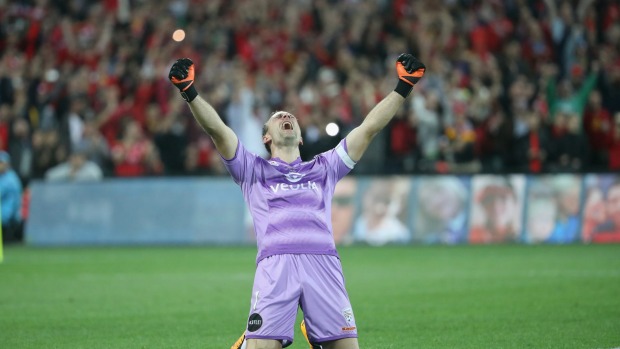You may have read somewhere that Leicester City won the English Premier League earlier this week. I know, it’s been kept pretty hush-hush.
Here is how one media outlet in Australia, Channel Nine, reported the triumph:

Several things wrong with that. Firstly, the 2-2 draw was between Tottenham Hotspur and Chelsea, with the Foxes only watching on intently. Second of all, and perhaps most importantly, the English Premier League doesn’t actually have finals. The winner is whoever finishes the season at the top of the ladder.
In Australia, though, we have the A-League. It might not have the glamour of La Liga or the history and romance of the Premier League, but it’s still the best football we Aussies get to cheer for short of waking up at 3am and watching EPL highlights on pay TV.
This explains the mistake of Channel Nine. Unlike the Premier League, the A-League actually does have finals, so to us, talk of a team winning the Premier League after a Grand Final makes logical sense.
10 teams compete in the overall competition, with the top 6 teams battling it out in a series of winner-takes all finals until only one team remains.
Here’s how it works: the team which finishes third takes on the team that finishes sixth on the ladder after 27 rounds, with fourth taking on fifth.
The winners then progress to take on second and first respectively. The winners of those two matches, held at the home grounds of the two top sides, progress to the Grand Final, to be held at the home ground of the highest-placing team playing.
Okay, so here’s why you should care about this, or even be vaguely aware of its existence in the world of football.
The last few weeks have seen some enthralling moments of football played in front of packed crowds, with particular highlights being the Brisbane Roar’s stunning come-from-behind win over Melbourne Victory, and the Western Sydney Wanderers’ 5-4 defeat of the Roar the very next week.
After a Besart Berisha goal put the Victory in front of the Roar with just five minutes remaining in the Elimination Final, the Roar not only equalised through a clever Matt McKay flick, but scored the match-winner in injury time after a header from midfielder Thomas Broich fizzed past Victory goalkeeper Lawrence Thomas, sparking scenes of jubilation at Suncorp Stadium (that’s in Brisbane).
Thrilling finishes? Check.
And then a week later, against the second-placed Western Sydney, the Roar looked to have a Grand Final spot sewn up after racing to a 3-0 lead after just 24 minutes, courtesy of some limp Western Sydney defending.
But before half time, the Wanderers had responded with goals from Romeo Castelen and Brendon Santalab, and by the 59th minute had hit the lead, two strikes from Santalab giving him a rare A-League hat-trick.
An 81st minute goal from Jamie Maclaren equalised for Brisbane and sent the match into extra time, but the Wanderers, courtesy of a 105th-minute winner from Vidosic, progressed to the Grand Final.
Large amounts of goals? Check.
And the Roar’s opponents? Adelaide United, who are as unlikely a Premier as the Foxes in the EPL. They may not have been £5000-1 odds to win the Championship, but United- also known as the Reds- had only scraped 3 points out of their first 8 matches to sit last on the table.
Yet over the next 19 weeks, they only lost once to snatch the Premiers’ Plate off the Brisbane Roar and Western Sydney Wanderers, in so doing earning a home Grand Final, which they ensured by beating Melbourne City (owned by the Manchester City-oriented City Football Group) in the Semi Final.
(As a side note, the Grand Final was played at the Adelaide Oval, primarily a ground for Australian Football League matches. As a result, the grass in the lead-up to the game was cut to AFL standards, which are several millimetres longer than that of a standard football pitch. Thus proving once and for all how the A-League is essentially the unpopular code in Australia, which is a crying shame.)
The Reds won the Grand Final, 3-1 in the end, with a late goal to substitute Pablo Sánchez sealing the deal.
So there we go. Thrilling finishes in important games? Yep. Games with lots of goals, which after all is the whole point of the sport? Yep. And a Cinderella rags-to-riches story that proves that football is a game in which miracles can still happen? Yep. (Although I do admit, that one with the Foxes is a pretty good one. And one that made Tom Hanks a very rich man.)
So there we have it. That’s why you should take the A-League seriously. Maybe Google it one time, or stream a game online. Maybe even come to Australia, settle in one of the many cities, come down to one of the games and watch it live. Seriously.
Our game may be small, but it’s growing bigger, and finals like these make it easy to see why.
